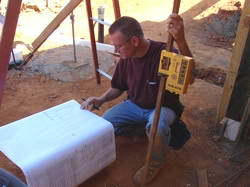» Home Electrical Wiring
» Electrical Wiring Directory
» Electrician Training
» Need Electrical Help? Ask the Electrician
» Electrician Training
» Need Electrical Help? Ask the Electrician
Electrical Project Guidelines

|
By Dave Rongey
Summary: Electrical Wiring Project Guidelines: Important for most any project you may choose to do. Follow a few simple steps that will help you understand the components necessary for a successful project from start to finish. © By: Dave Rongey |
Home Electrical Wiring Project Planning Guidelines
For electrical projects large or small, project planning is essential for any activity to be successful. The benefits will bring added value to your home.
Consideration must be given to the following:
Local and National Electrical Codes.
Local and National Energy Reduction Guidelines.
Local and National Fire Prevention Requirements.
Steps to Successful Home Electrical Wiring Projects |
|
| Plan the installation of your electrical project or device. | |
| Produce a Set of Blueprint Drawings or Plans. | |
| Investigate local electrical codes compliance and ordinances. | |
| Who will perform the electrical project? Based upon your local jurisdiction, some areas allow homeowners to perform specified home projects. Be sure to carefully discuss your project with your local building department authority before proceeding with any home project. Be sure to understand all levels of liability for every aspect of the project and those who will be involved with the project. Consider the list of Guidelines for Hiring an Electrician when contacting electricians in your area. |
|
| Submit the set of plans for approval and obtain an electrical permit. | |
| Determine the required electrical circuit power. | |
| Determine the electrical wire size and circuit protection. | |
| If branching from an existing electrical circuit then match the existing wire gauge and insulation type. | |
| Identify the electrical wiring path and components necessary to protect the circuit wiring. | |
| Develop a material list, call for competitive electrical materials pricing and purchase materials. | |
| Locate or contract special electrical tools, equipment or services. | |
| Install the circuit components at the appropriate phase of construction project. | |
| Attach ground bonding, identify and make up wiring splices. | |
| Verify the circuit path and components, then test the electrical circuit. | |
| Schedule and obtain electrical inspections for each phase of the project. | |
|
Electrical Safety Checklist Before working with electrical wiring: Always use a good quality tester. Identify and label the circuit(s). Shut the circuit off before beginning any work. Advise Others that you are working on the circuit wiring. |
 |
The Safest Way to Test Electrical Devices and Identify Electric Wires!The Non-Contact Electrical TesterThis is a testing tool that I have had in my personal electrical tool pouch for years, and is the first test tool I grab to help identify electrical wiring. It is a Non-contact tester that I use to easily Detect Voltage in Cables, Cords, Circuit Breakers, Lighting Fixtures, Switches, Outlets and Wires. Simply insert the end of the tester into an outlet, lamp socket, or hold the end of the tester against the wire you wish to test. Very handy and easy to use.
The Quickest Way to Check for Faulty Electrical Wiring!The Plug-In Outlet TesterThis is the first tool I grab to troubleshoot a problem with outlet circuit wiring. This popular tester is also used by most inspectors to test for power and check the polarity of circuit wiring. It detects probable improper wiring conditions in standard 110-125 VAC outlets Provides 6 probable wiring conditions that are quick and easy to read for ultimate efficiency Lights indicate if wiring is correct and indicator light chart is included Tests standard 3-wire outlets UL Listed Light indicates if wiring is incorrect Very handy and easy to use.
Strip Off Wire Insulation without Nicking and Damaging the Electric Wire!The Wire Stripper and Wire CutterMy absolute favorite wire stripping tool that I have had in my personal electrical tool pouch for years, and this is the tool I use to safely strip electrical wires. This handy tool has multiple uses: The wire gauges are shown on the side of the tool so you know which slot to use for stripping insulation. The end of the tool can be used to grip and bend wire which is handy for attaching wire onto the screw terminals of switches and outlets.. The wire stripper will work on both solid and stranded wire. This tool is Very Handy and Easy to Use. |
||
Residential Electrical Parts and AccessoriesLight Switches 120volt Outlets Circuit Breakers Electrician Tools Voltage Testers |















